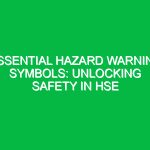Introduction
Health hazard signs are essential tools in the realm of Health, Safety, and Environment (HSE). These signs serve as visual cues designed to inform individuals about potential health risks in their surroundings. Whether in a manufacturing plant, a laboratory, or an office, understanding these signs is crucial for maintaining a safe workplace. They not only provide immediate warnings but also play a significant role in fostering a culture of safety. This article delves deep into the significance of health hazard signs, their various types, regulatory standards, and best practices for implementation, ensuring that all employees can navigate potential hazards effectively.
Understanding Health Hazard Signs
Health hazard signs are part of a broader classification of warning signs that communicate specific risks associated with hazardous materials or conditions. They are designed to be easily recognizable, often using standardized symbols and colors. The primary aim of these signs is to prevent accidents and promote safety awareness among employees and visitors.
The Importance of Health Hazard Signs
The relevance of health hazard signs cannot be overstated. These signs act as a first line of defense against workplace accidents. They serve multiple purposes:
- Informing Employees: Health hazard signs communicate crucial information about potential risks, ensuring that employees are aware of their environment.
- Regulatory Compliance: Many industries are mandated by law to display health hazard signs. Compliance with these regulations not only protects employees but also shields organizations from legal repercussions.
- Promoting a Safety Culture: Visible health hazard signs contribute to a culture of safety, encouraging employees to prioritize their well-being and that of their colleagues.
Types of Health Hazard Signs
Understanding the various types of health hazard signs is vital for effective workplace safety management. These signs can be categorized into different types based on the risks they represent:
- General Health Hazard Signs: These signs indicate the presence of a health hazard that may not be immediately apparent, such as toxic substances or biological hazards.
- Specific Hazard Signs: These include signs for specific chemicals (like “Corrosive” or “Poison”) that detail the nature of the risk.
- Emergency Signs: Signs that indicate the presence of emergency equipment, such as eyewash stations or safety showers, are crucial for immediate response in hazardous situations.
Best Practices for Implementing Health Hazard Signs
To effectively utilize health hazard signs, organizations should adhere to several best practices:
1. Conduct a Risk Assessment
Before implementing health hazard signs, conduct a thorough risk assessment. Identify potential hazards in the workplace and determine the best locations for signs to ensure maximum visibility. This process helps in tailoring the specific messages and symbols used on the signs, ensuring they are relevant to the actual risks present.
2. Use Standardized Symbols and Language
Health hazard signs should use standardized symbols, as provided by organizations like the Occupational Safety and Health Administration (OSHA) or the International Organization for Standardization (ISO). These symbols are universally recognized and help reduce confusion. Additionally, use clear and concise language to convey the message, avoiding technical jargon that might confuse employees.
3. Regularly Review and Update Signs
Workplace conditions can change, and so can the associated hazards. Regularly review the health hazard signs to ensure they remain relevant and up to date. If new materials are introduced or workplace processes change, reassess the risks and update the signage accordingly.
4. Train Employees
Training is crucial for the effective use of health hazard signs. Employees should understand the meaning of various signs and how to respond when they encounter them. Regular training sessions can reinforce this knowledge and ensure that safety remains a priority.
Potential Hazards and Risks
While health hazard signs serve to mitigate risks, it’s essential to understand the types of hazards they represent. Here are some common health hazards encountered in various workplaces:
Chemical Hazards
Chemical hazards are prevalent in many industries, particularly in manufacturing and laboratories. Signs indicating the presence of corrosive substances, flammable materials, or toxic chemicals are essential for preventing exposure. For instance, a “Toxic” sign alerts employees to substances that can cause serious health issues upon contact or inhalation.
Biological Hazards
In healthcare settings, biological hazards such as viruses, bacteria, and other pathogens pose significant risks. Signs indicating the presence of biohazards can help prevent the spread of infections. For example, a “Biohazard” sign identifies areas where potentially infectious materials are present, ensuring that appropriate precautions are taken.
Physical Hazards
Physical hazards, such as excessive noise, radiation, or extreme temperatures, can also be communicated through health hazard signs. For instance, a “High Noise Area” sign alerts employees to use hearing protection, while a “Radiation Area” sign indicates the need for protective measures in specific zones.
Regulations and Standards Governing Health Hazard Signs
Several regulations and standards govern the use of health hazard signs, ensuring consistent messaging and safety practices across industries. Understanding these regulations is crucial for compliance and effective workplace safety management.
Occupational Safety and Health Administration (OSHA)
OSHA provides guidelines on labeling hazardous materials and the use of safety signs. These guidelines require that health hazard signs are clearly visible and understandable to all employees. Compliance with OSHA standards helps organizations avoid penalties and fosters a safer work environment.
Globally Harmonized System of Classification and Labelling of Chemicals (GHS)
The GHS is an internationally recognized system for classifying and labeling chemicals. It ensures that health hazard signs are standardized across borders, making it easier for employees to recognize hazards regardless of their location. The GHS incorporates symbols and signal words that convey the nature of the hazard quickly and effectively.
Local and Industry-Specific Regulations
In addition to federal regulations, many states and specific industries have their own regulations regarding health hazard signs. Organizations must familiarize themselves with these local requirements to ensure compliance.
Real-Life Examples of Health Hazard Sign Implementation
Implementing health hazard signs effectively can significantly impact workplace safety. Here are some real-life examples:
Case Study: A Chemical Manufacturing Plant
In a chemical manufacturing plant, management conducted a thorough risk assessment and found that various hazardous chemicals were being handled daily. They implemented a comprehensive signage system that included color-coded signs for different types of hazards—red for flammable materials, yellow for corrosive substances, and blue for toxic chemicals. This clear system not only improved safety awareness among workers but also reduced the number of incidents related to chemical exposure.
Case Study: A Hospital
In a hospital setting, the presence of biological hazards is a significant concern. The facility adopted a rigorous training program that taught staff to recognize and respond to biohazard signs effectively. After implementing this program, the hospital saw a marked decrease in the transmission of infections, showcasing the effectiveness of clear signage and employee training.
Conclusion
In conclusion, health hazard signs are vital components of workplace safety in the HSE domain. They serve as critical tools for informing employees about potential risks, ensuring regulatory compliance, and promoting a culture of safety. By understanding the various types of health hazard signs, implementing best practices, and adhering to relevant regulations, organizations can significantly enhance the safety and well-being of their workforce. As workplaces evolve, the importance of these signs will only grow, making it imperative for organizations to prioritize their proper use and maintenance. Through continued education and vigilance, we can create safer environments for everyone involved.


